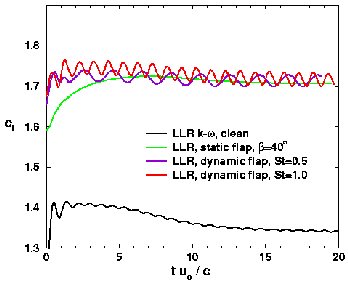Effect of an Oscillating Flap
Experimental investigations with movable flaps sometimes show high-frequency flap motions. In additional numerical simulations, the flap is oscillating around a mean flap angle similar to a flow-control device. To capture the effect of time-dependent flap angles, the mesh needs to distort at every time step and the equations of motion must take the space conservation law into account. Different excitation frequencies however does not significantly enhance the lift coefficient.
 Unsteady lift coefficient over non-dimensional time
Unsteady lift coefficient over non-dimensional time
at different frequencies for the oscillating flap at  = 38° + 2° cos
= 38° + 2° cos 
Conclusions
- Movable flaps effects to 10% increase in lift and up to 10% reduction in drag.
- Best results are obtained by the LLR k-
 turbulence model.
turbulence model.
- For a static flap in equilibrium position almost optimum lift is predicted
- Optimum lift coefficient can not be realized by a self- adjusting movable flap
- Flap will adjust at position where the free shear-layer is slightly touched
- Strouhal number for the flap in equilibrium position equals that of the clean airfoil
- Flow control by oscillating flap does not show promising results
- Effect of movable flaps can be captured by a URANS flow simulation on a distortable mesh
Webmaster
Last modified: Thu Jul 27 18:01:15 CEST 2000

 = 38° + 2° cos
= 38° + 2° cos 
 = 38° + 2° cos
= 38° + 2° cos 